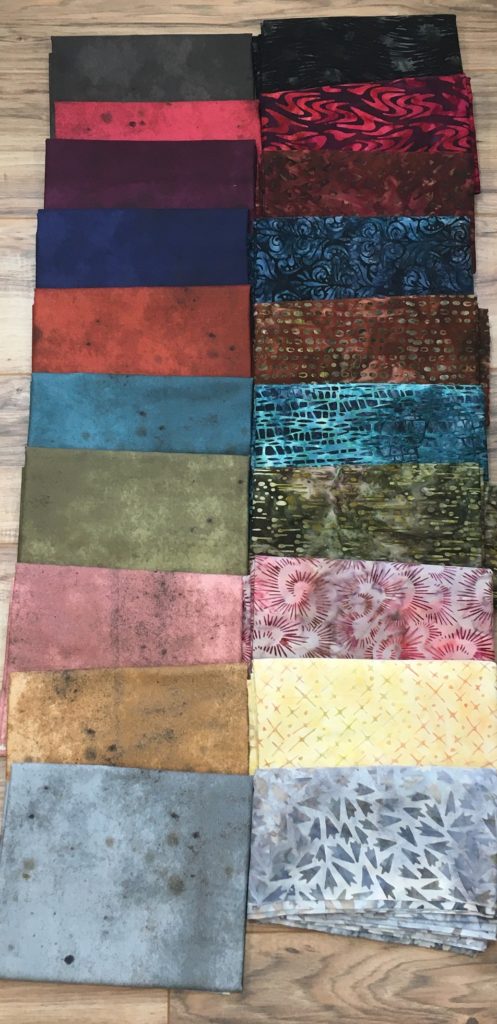I’m taking on the longest and most intense project I’ve attempted thus far: the Anxiety and Mood Quilt, title still a work in progress. From February 2021 until a year from now, I am tracking my anxiety and mood levels and turning these values into a quilt. Say what? Hang on, let me try to explain. I’ve been watching other quilters talk about creating ‘temperature quilts’ – tracking their local temperature highs and lows and using that data to create a quilt. The Modern Quilt Guild had a neat webinar about three quilters and their processes. After watching the webinar, I was ready to track the weather and dive right in. And then my husband suggested that I might consider a mood quilt instead.
Headspace Battle
Full disclosure, I have an anxiety disorder, and deal with a double whammy of season affected disorder also. I battle with my head every day in some fashion or other, and I can assure you there is nothing romantic about spending that much time thinking about the future and what might or might not happen, nor about the past and reliving every single bad thing and every infraction that happened from childhood to the present. That might sound bad, or just relatable (if so, I’m sorry to hear that), but for the most part it’s just a running commentary that runs through my head. Somedays it’s far more present, and others, background static.
So knowing that I have anxiety issues, my hubby suggested the mood quilt as a way to see patterns, if there are any, over the course of a year. Yeah, I know, I could just journal, blah blah. But I’m an art quilter. If I’m going to put that amount of effort into a project it has to involve fabric. Marry the mental health with the creativity sounds like a win to me. If you want to follow along with the process, sign up for my newsletter. I’m happy to talk about mental health and creativity and answer questions on social media. They’re connected, and we’re not alone.
Criteria for the anxiety and mood quilt:
- There are two categories, one for anxiety and one for mood.
- The batik pattern fabrics represent the anxiety levels, and the solid(ish) fabrics align with mood.
- Both categories scale from one to ten.
- Values range from overwhelming anxiety to not anxious at all, and depression to joy.
- A legend will be included with the quilt (I’m thinking on the back?) but I will keep the definitions to myself until the quilt blocks are complete.

Choosing fabrics:
This was extremely tricky. I wanted to purchase the fabrics ahead of time to correlate the anxiety and mood levels with visual representations. Without knowing how the amount of fabric I would need – I have no idea in advance how my year is going to go, right? – I bought the same amount for each level. I anticipate having a lot of leftover fabric for specific points that I don’t see happening. How many anxiety free days am I going to have? I’m sure you can hear the sarcastic laughter from there. As my hubby reminded me though, stranger things have happened, so it’s better to be prepared.
I also wanted the fabrics to have a similar value despite the range of colors. I’ve always loved Tim Holtz fabric and have made multiple projects from those lines. I went searching on Etsy and found a shop that had exactly what I was looking for (thank you, Quilting by Rita). There are some of you quilters that might be wondering why I didn’t just go with solids. For a quilt that is going to be this personal, it needs to reflect me, and my first love is muted colors and vintage style. So I chose the ‘solids’ that have an old world feel to them. I’m in love, honestly.
The anxiety representing batiks were tough, especially since I was purchasing online and matching color tone is difficult. Fortunately, LunnFabrics has an incredible selection. I did end up purchasing a couple extra colors after receiving the first batch since there were a couple designs that missed the mark. Now I have extra batik fabric, oh darn. The horrors, eh? Extra fabric.
The Design:
The overall quilt is still a work in progress. I’m adapting it from a design called Cakewalk by Mary Jacobson and Barbara Groves of Me and My Sister Designs. The pattern is located in ‘The Big Book of Lap Quilts’ by That Patchwork Place. The blocks will definitely be smaller due to the amount – 365 blocks makes a huge quilt regardless. I needed the basic concept that would be simple enough that I wouldn’t quit partway through, but also let the batik fabric shine and show off the color of the textured solid fabrics. It needed to be completely adaptable, as I think the blocks will end up grouped in either months or seasons depending on what it feels like. Consider it still a work in progress, but I’ll post the process as I go along, good and bad.
Want to follow along? Sign up for my newsletter, or follow me on social media, both located in the right hand navigation. I’d love to have your thoughts.